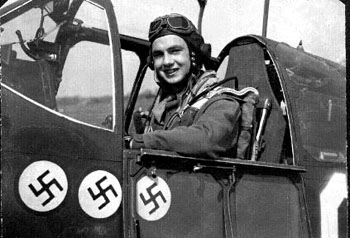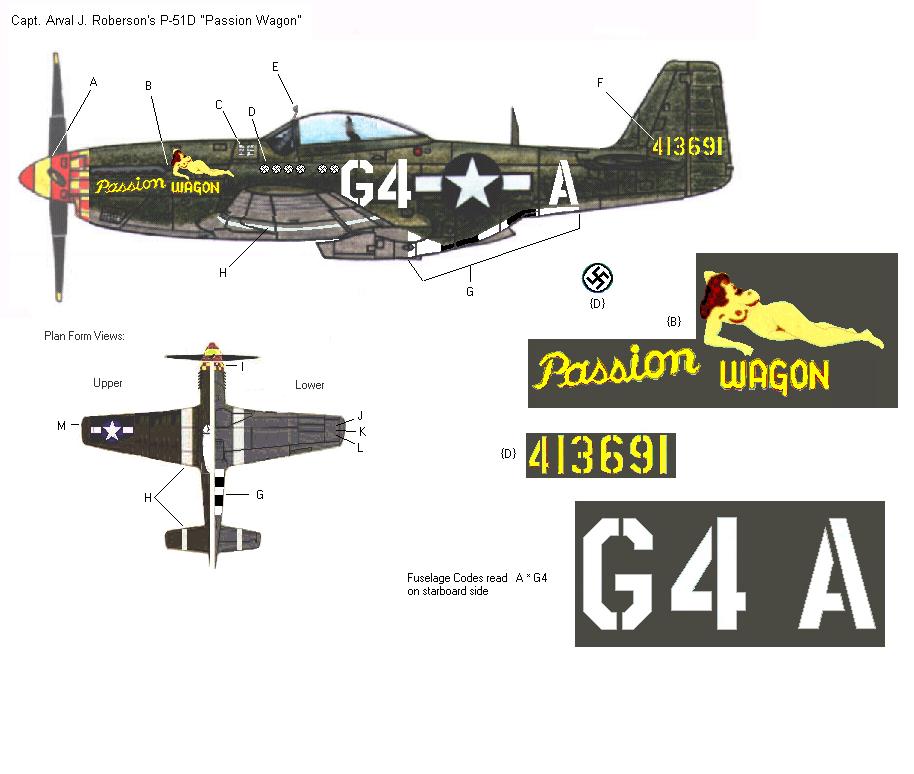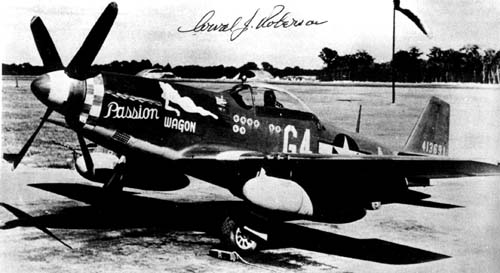357th FG Profile

1st Lt.. Arval J. Roberson’s P-51D Mustang “Passion Wagon”


Note from Merle Olmsted: This plane was accepted by the AAF on 31 May 44, ferried to Newark in late June, departing the US on 23 June 44. It would have arrived in England early in July and at Leiston probably in late July. Robie flew it on the Shuttle Mission in August. This photo confirms our Modeling Tip below.
Autumn 1944
Modeler Tips:
A. Rear red band on propeller boss extends onto spinner to leading edge of blades when in
neutral pitch. Determine width of yellow band by dividing remainder of spinner evenly.
B. Very inviting nose art situated just aft of exhaust manifold. Model twisted at the waist and looking back to her left resting on her right elbow. Left leg slightly bent at the knee, resting over right leg.
C. Names of Pilot, Crew Chief, and Armorer in cursive, names swept upward at a 30 degree angle.
D. Six kill markings- black swastikas on white circles bordered in black. Note gap between 4th and 5th kills.
E. Standard ETO round mirror, canopy framework left natural aluminum.
F. Tail Number- “413” on fin, “691” on rudder.
G. Reduced invasion stripes on lower surface of fuselage only.
H. White ID Bands on wings and stabilizers.
I. The name “Passion Wagon” rendered in to typefaces- the
word “Wagon” sits squarely within lower strip panel.
Upper & Lower View Notes:
G. Repeat of item “G” from Side View Notes.
H. Repeat of item “H” from Side View Notes.
I. Width of checker reduced on underside in order to fit evenly on the
narrow surfaces of the chin scoop area.
J, K, L. Red, Green, Yellow navigation lights- circular and flush with wing panel.
M. Formation Lights- Red (Port) and Green (Starboard)
Overall Modeling Tips:
*Sources differ concerning the invasion stripes on this A/C. Some decal manufacturers depict the aircraft with no invasion stripes, some artists have rendered the aircraft with half-style invasion stripes similar to those found on Peterson’s earlier “Hurry Home Honey”. Mr. Merle Olmsted, renowned 357th Crew Chief states in his book “The 357th Over Europe” that he regarded the “Passion Wagon” as the most attractive P-51D in the group- our diagram is consistent with his own illustration.
*Apply victories and fuselage codes from nose tail ward to ensure proper spatial relationships.
*After building several 357th A/C over the past 30 years, I recommend
painting the nose area forward of the exhaust cutout yellow when the flat features are painted. Carefully cut away the yellow squares from the checkerboard decal and apply the remaining strip of red checkers to the nose. This method significantly reduces the potential for bubbles, and wrinkles plus it makes exact alignment of the decal easier.
*Prior to assembly, wash clear plastic parts with a mild glass cleaner and gently wipe dry. Then use a Q-Tip to evenly spread clear liquid floor wax (Future Brand seems to get the best results) on both inside & outside. Protect from dust and let dry for at least 2 hours. The wax fills in microscopic flaws and creates an even gloss that is clearer & shines brighter than the original plastic underneath.

Art work painted by mechanic Robert Child.
Aeromaster Decal Sheet 48-071, SuperScale Decal Sheets 48-001 and 48-692

